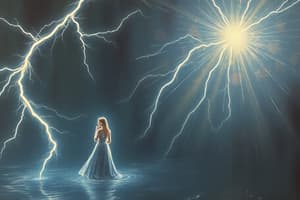Podcast
Questions and Answers
What are the two types of electric charge?
What are the two types of electric charge?
- Proton and electron
- Positive and neutral
- Positive and negative (correct)
- Neutral and negative
Electric charge is quantized, meaning it can take any continuous value.
Electric charge is quantized, meaning it can take any continuous value.
False (B)
What unit is used to measure the electric field?
What unit is used to measure the electric field?
N/C
Electric potential, also known as voltage, is the potential energy per unit charge at a given point in space. It is measured in units of V (volts). Its negative gradient gives the electric _____.
Electric potential, also known as voltage, is the potential energy per unit charge at a given point in space. It is measured in units of V (volts). Its negative gradient gives the electric _____.
Match the following electromagnetic waves with their frequencies:
Match the following electromagnetic waves with their frequencies:
Flashcards are hidden until you start studying
Study Notes
Electromagnetism
Electric Charge
- Electric charge is a fundamental property of matter, characterized by two types: positive and negative.
- Like charges repel each other, while opposite charges attract each other.
- Electric charge is quantized, meaning it comes in discrete packets (quanta) rather than being continuous.
Electric Field
- Electric field is a vector field that surrounds charged particles, representing the force per unit charge at a given point in space.
- Electric field is measured in units of N/C (newtons per coulomb).
- Electric field lines emerge from positive charges and enter negative charges.
Electric Potential
- Electric potential, also known as voltage, is the potential energy per unit charge at a given point in space.
- Electric potential is measured in units of V (volts).
- Electric potential is a scalar quantity, and its negative gradient gives the electric field.
Electromagnetic Induction
- Electromagnetic induction is the process by which a changing magnetic field induces an electric field.
- Faraday's law of induction states that the induced electromotive force (EMF) is proportional to the rate of change of the magnetic flux.
Magnetic Fields
- Magnetic fields are created by the motion of charged particles or by changing electric fields.
- Magnetic fields are measured in units of T (tesla).
- Magnetic field lines emerge from the north pole and enter the south pole.
Electromagnetic Waves
- Electromagnetic waves are waves that propagate through the electromagnetic field, consisting of electric and magnetic field components.
- Electromagnetic waves can transmit energy through space without the need for a medium.
- Electromagnetic waves have a wide range of frequencies, including radio waves, microwaves, infrared radiation, visible light, ultraviolet radiation, X-rays, and gamma rays.
Lorentz Force
- The Lorentz force is the force experienced by a charged particle moving through a magnetic field.
- The Lorentz force is given by the equation F = q(E + v x B), where q is the charge, E is the electric field, v is the velocity, and B is the magnetic field.
Electric Charge
- Two types of electric charges exist: positive and negative, which interact via repulsion and attraction respectively.
- Electric charge is quantized, meaning it comes in discrete packets rather than being continuous.
Electric Field
- An electric field is a vector field surrounding charged particles, representing the force per unit charge at a given point in space.
- Electric field is measured in units of N/C (newtons per coulomb).
- Electric field lines emerge from positive charges and enter negative charges.
Electric Potential
- Electric potential, also known as voltage, is the potential energy per unit charge at a given point in space.
- Electric potential is measured in units of V (volts).
- Electric potential is a scalar quantity, with its negative gradient giving the electric field.
Electromagnetic Induction
- Electromagnetic induction occurs when a changing magnetic field induces an electric field.
- Faraday's law of induction states that the induced electromotive force (EMF) is proportional to the rate of change of the magnetic flux.
Magnetic Fields
- Magnetic fields are created by the motion of charged particles or by changing electric fields.
- Magnetic fields are measured in units of T (tesla).
- Magnetic field lines emerge from the north pole and enter the south pole.
Electromagnetic Waves
- Electromagnetic waves are waves that propagate through the electromagnetic field, consisting of electric and magnetic field components.
- Electromagnetic waves can transmit energy through space without the need for a medium.
- The frequency range of electromagnetic waves includes radio waves, microwaves, infrared radiation, visible light, ultraviolet radiation, X-rays, and gamma rays.
Lorentz Force
- The Lorentz force is the force experienced by a charged particle moving through a magnetic field.
- The Lorentz force equation is F = q(E + v x B), where q is the charge, E is the electric field, v is the velocity, and B is the magnetic field.
Studying That Suits You
Use AI to generate personalized quizzes and flashcards to suit your learning preferences.




